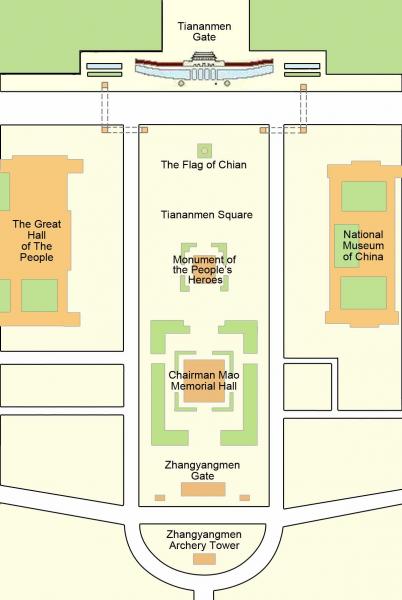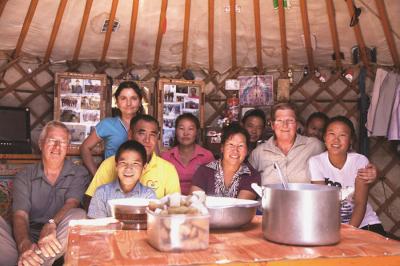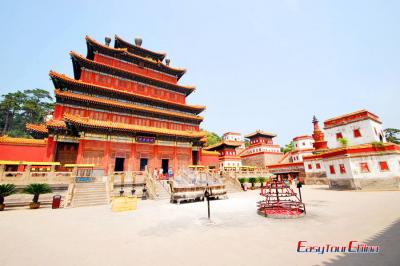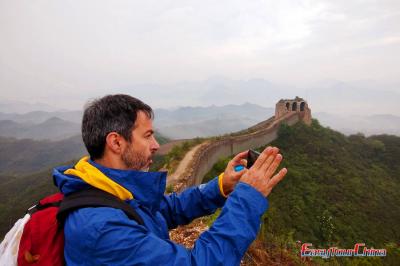Tiananmen Square
Beijing Tiananmen Square is a national symbol of modern China, which literally means “Gate of Heavenly Peace”. It was first built during the Ming Dynasty, served as the gatehouse – the entrance to the Imperial City.
As one of the top thing to do in Beijing, Tiananmen Square is visited by tens of millions of tourists every year. Chinese people love to watch the flag-raising ceremony in Tiananmen Square. More than 300,000 people came to watch the flag-raising ceremony during the 2023 National Day.
What is Tiananmen Square
Tiananmen Square, after many revisions and changes, finally formed a north-south length of 880 meters, east-west width of 500 meters. With an area of 440,000 square meters, it is the largest city square in the world and can accommodate 1 million people.
The building is located in the central axis of Beijing, south end of the Forbidden City, and the northern edge of Tiananmen Square, separated from the Tiananmen Square, Monument to the People’s Heroes, Chairman Mao Memorial Hall, Great Hall of the People and National Museum of China by the Chang’an Avenue.
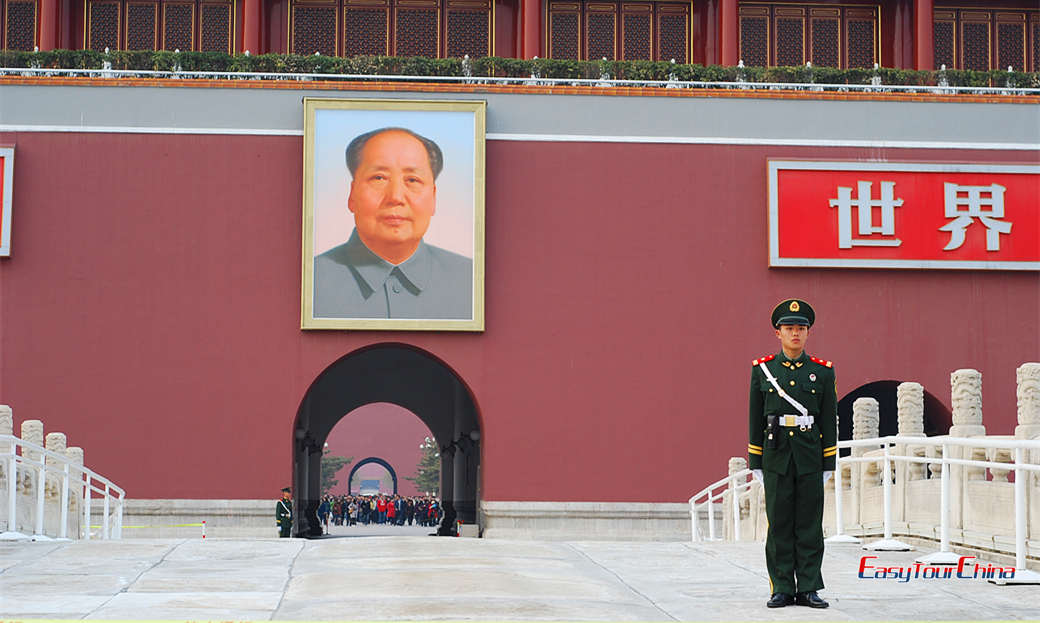
It is 66 meters long, 37 meters wide and 32 meters high, and made up of a platform and a tower. Under the platform, there are five archways. The largest of the five is right at the center. In history, the central archway is specifically used for Ming and Qing emperors passing through, while the side smaller ones are used as the passages for ministers and officials. Above the largest archway hang a big portrait of chairman Maozedong and two large placards on both sides of it. One reading: “Long Live the People’s Republic of China”. The other one reading: “Long Live the Great Unity of the World’s Peoples”. Like other official classical Chinese architecture, the whole building has unique imperial roof decorations – large overhanging eaves.
Tiananmen Square Facts
History
When Was the Tiananmen Square Built
Tian'anmen Square was first built in 1420 AD, in the 18th year of Yongle in the Ming Dynasty. At that time, it was named "Tianjie", a closed court square in the shape of a "T" outside the Chengtian Gate (now Tiananmen), the main gate of the Forbidden City. At the east and west ends of Tianjie Street, there were respectively the left and right gates of Chang 'an. At the southern end of the square, there was the Daming Gate. During the Qing Dynasty, Beijing city inherited the old style of the Ming Dynasty, only changing the names of some of its city gates. The Chengtian Gate was renamed Tian'anmen.
During the Ming and Qing Dynasties, Tiananmen Square was both a place of etiquette for the feudal dynasty and a royal forbidden place. The common people were strictly forbidden to enter.
What Happened in Tiananmen Square
In 1911, the Xinhai Revolution put an end to the monarchical dictatorship that had existed in China for thousands of years. On February 12, 1912, Empress Dowager Longyu issued an abdication edict in the name of Emperor Xuantong (Puyi) on the Tiananmen Square Citadel.
On May 4, 1919, thousands of students gathered in the vicinity of Tiananmen Square and demanded a response from the government with slogans such as “Struggle for Sovereignty Externally, Punish the Traitors of the State Internally”. In 1928, Chiang Kai-shek won the Second Northern Expedition to end the warlord war, so in July of that year, Beiping military and political circles organized 70,000 people in front of Tiananmen Square to celebrate the victory. On August 24 of the same year, Sun Yat-sen's portrait was hung on Tiananmen Square, which was the first time a portrait of an individual was hung on Tiananmen Square. After the victory of the war in 1945, Chiang Kai-shek's portrait was also hung on Tiananmen Square for a short period of time.
On October 1, 1949, Chairman Mao solemnly proclaimed to the world from Tiananmen Square, “The Central People's Government of the People's Republic of China is established today!” Tiananmen Square has been the symbol of the People's Republic of China ever since.
Significance
From a historical perspective, Tiananmen Square witnessed the transformation of China from a feudal dynasty to a modern state. Its symbolism changed from a symbol of imperial power to a symbol of the people, reflecting the great changes and progress of China's social system. Politically, Tiananmen is the political center of China. Culturally, Tiananmen Square blends elements of traditional Chinese architectural culture and modern culture.
Tiananmen also symbolizes China's openness. As one of the highlights of Beijing travel, it welcomes friendly envoys and tourists from all over the world.
>> Recommended China tour packages with Tiananmen Square:
What to See
Monument to the People's Heroes
Completed in April 1958, the Monument to the People's Heroes is located in the right center of Tiananmen Square. It consists of two tiers of platforms, two tiers of Sumeru seats, monument bodies and monument tops. It is 37.94 meters high, 50.44 meters wide from east to west, and 61.54 meters long from north to south, using more than 17,000 pieces of granite and alabaster.
On the front side of the monument, there are eight gilt characters engraved on the stone in the center of the monument with the inscription “People's Heroes Forever” written by Chairman Mao Zedong. On the back is a 150-word inscription written by Chairman Mao Zedong and inscribed by Premier Zhou Enlai.
Chairman Mao Memorial Hall
Located in Tiananmen Square, the Memorial Hall of Chairman Mao is a place to pay homage to the remains of Chairman Mao. It covers an area of 5.72 hectares, with a total construction area of 33,867 square meters. It was built in November 1976 and was inaugurated on September 9, 1977 and opened to the public.
Chairman Mao, dressed in a gray Zhongshan suit and covered with the flag of the Communist Party of China (CPC), lies peacefully in a crystal clear crystal coffin.
Through a large number of photographs, documents and objects, the Memorial Hall showcases the great achievements of Mao Zedong in all periods of China's revolution and construction.
Zhengyangmen
Zhengyangmen, commonly known as Qianmen, formerly known as Lizhengmen, was the southern gate of the inner city of Beijing during the Ming and Qing dynasties. It is located at the southernmost tip of Tiananmen Square on the north-south axis of Beijing, south of Chairman Mao's Memorial Hall.
Built in the 17th year of the Yongle reign of Emperor Chengzu of the Ming Dynasty (1419), Zhengyangmen is one of the “Nine Gates of the Capital” in old Beijing. It is the only well-preserved city gate in Beijing, with only the city tower and the archery tower remaining.
Zero Mile or Kilometer Markers
Just outside the Zhengyangmen Gate in Tiananmen Square, it marks an iconic starting point for China's highway network. The main design is based on the ancient Chinese symbols of direction: Green Dragon, White Tiger, Vermilion Bird, Xuanwu and the seal characters for East, West, South, North and South. The zero point in the middle of the logo uses the Arabic numeral “0” as a meta-point. And the full name “China Highway Zero Kilometer Point” in English and Chinese is used around the zero point. The outer ring of the logo uses 64 points to represent the 64 directions in traditional Chinese culture.Golden Water Bridge
In front of the Tiananmen Tower, there are 5 beautiful white arch-type marble bridges - golden water bridges. Like the arch gateways, the central bridge is the widest one, which was served only for the emperor.
Huabiao
Two stone columns, carved with dragon design, called Huabiao standing in front of the Tiananmen Tower, and each of them has a stone animal on top as decoration, one is called “Wangtianhou”, and the other one is called “Wangjungui”. Originally, they were used for the common people to present a petition by writing on the columns, but now, the Huabiao become purely decoration and a kind of demonstration of royal majesty.
Stone lions
Outside the gate, two pair of stone lions sitting there. One pair is guarding the gate, and the other pair is guarding the bridges. In Chinese culture, lions are believed to be a mascot, which can protect humans from evil spirits. They are elaborately carved with a whole stone and so lifelike. You can enjoy the artistic carving technics of Ming Dynasty.

Tiananmen Square
Tiananmen Square is the largest city square in the world. It can accommodate a million people to hold a large rally. It recorded the revolution of the Chinese people’s indomitable spirit and fearless heroism. There are many important political events occurred here. So to speak, Tiananmen Square is the witness of China from fading to rise of history.
Tiananmen Rostrum
Designed by Zhang Kaiji and rebuilt in 2004, the rostrum has a total floor area of 4008 square meters and can accommodate more than 10,000 people.
National Museum of China
It is located on the east side of Tian 'anmen Square. The collection consists of over 1.43 million items, covering various categories such as ancient cultural relics, modern and contemporary cultural relics, and artworks.
Tiananmen Square Today
Nowadays, more and more national celebrations, foreign affairs welcoming and commemorations are held in Tiananmen Square. The congresses celebrating the 100th anniversary of the founding of the Communist Party of China, the 35th, 50th, 60th and 70th anniversaries of the founding of the People's Republic of China, and the 70th anniversary of the victory of the Chinese People's War of Resistance Against Japanese Aggression and the World Anti-fascist War are all held here.
Every year on China's National Day, grand military parades and mass processions are also held in Tiananmen Square. In addition, various cultural activities, such as cultural performances and calligraphy exhibitions, are regularly held in the square. And on traditional festivals such as the Chinese Lunar New Year, lantern shows and folklore performances are held in the square.
When to Visit
Tiananmen Tower Opening Hours: 8:30-16:30
Tiananmen Square Opening Hours: 5:00-22:00
How to Get Here
You can get here by bus or subway, and get off at Tiananmen West or Tiananmen East.
Travel Tips:
1.Before visiting the Tiananmen Square, you will need to pass through a security checkpoint, including being asked for identification. So you should better bring your passport with you at all time.
2.Take a close look at the official notice to Tiananmen visitors.
3.If you want to go up to visit the Tiananmen Tower, bags are not allowed. And the bag storage service is provided.
4.Avoid wearing clothes which printed with political or religion themes or information, like “Free Taiwan” shirts.
